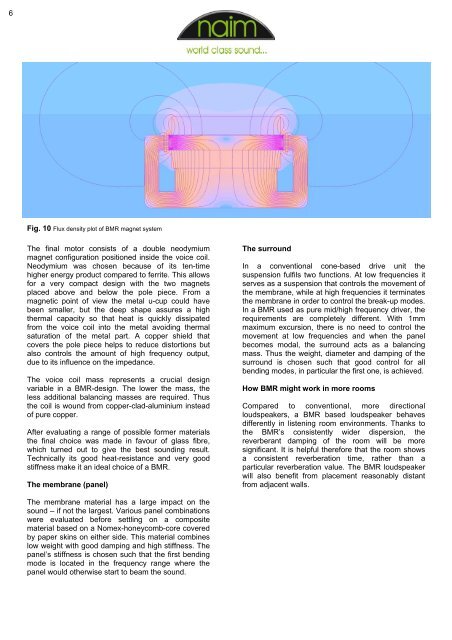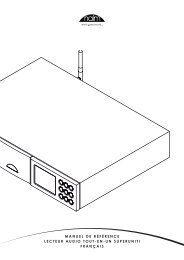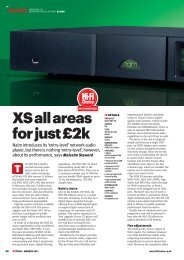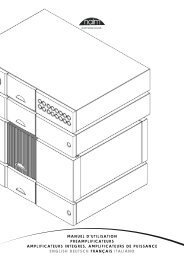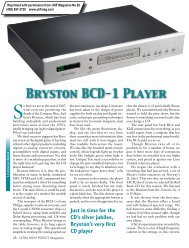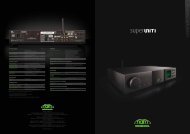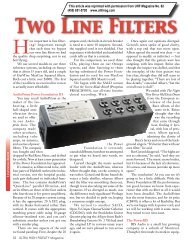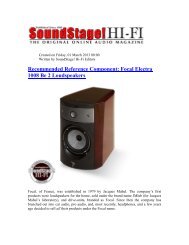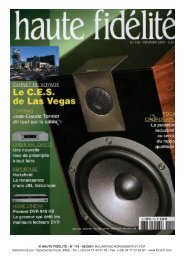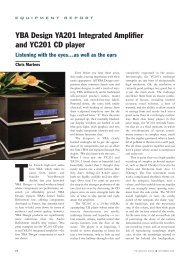The Naim Balanced Mode Radiator - Naim Audio
The Naim Balanced Mode Radiator - Naim Audio
The Naim Balanced Mode Radiator - Naim Audio
You also want an ePaper? Increase the reach of your titles
YUMPU automatically turns print PDFs into web optimized ePapers that Google loves.
6<br />
Fig. 10 Flux density plot of BMR magnet system<br />
<strong>The</strong> final motor consists of a double neodymium<br />
magnet configuration positioned inside the voice coil.<br />
Neodymium was chosen because of its ten-time<br />
higher energy product compared to ferrite. This allows<br />
for a very compact design with the two magnets<br />
placed above and below the pole piece. From a<br />
magnetic point of view the metal u-cup could have<br />
been smaller, but the deep shape assures a high<br />
thermal capacity so that heat is quickly dissipated<br />
from the voice coil into the metal avoiding thermal<br />
saturation of the metal part. A copper shield that<br />
covers the pole piece helps to reduce distortions but<br />
also controls the amount of high frequency output,<br />
due to its influence on the impedance.<br />
<strong>The</strong> voice coil mass represents a crucial design<br />
variable in a BMR-design. <strong>The</strong> lower the mass, the<br />
less additional balancing masses are required. Thus<br />
the coil is wound from copper-clad-aluminium instead<br />
of pure copper.<br />
After evaluating a range of possible former materials<br />
the final choice was made in favour of glass fibre,<br />
which turned out to give the best sounding result.<br />
Technically its good heat-resistance and very good<br />
stiffness make it an ideal choice of a BMR.<br />
<strong>The</strong> membrane (panel)<br />
<strong>The</strong> surround<br />
In a conventional cone-based drive unit the<br />
suspension fulfils two functions. At low frequencies it<br />
serves as a suspension that controls the movement of<br />
the membrane, while at high frequencies it terminates<br />
the membrane in order to control the break-up modes.<br />
In a BMR used as pure mid/high frequency driver, the<br />
requirements are completely different. With 1mm<br />
maximum excursion, there is no need to control the<br />
movement at low frequencies and when the panel<br />
becomes modal, the surround acts as a balancing<br />
mass. Thus the weight, diameter and damping of the<br />
surround is chosen such that good control for all<br />
bending modes, in particular the first one, is achieved.<br />
How BMR might work in more rooms<br />
Compared to conventional, more directional<br />
loudspeakers, a BMR based loudspeaker behaves<br />
differently in listening room environments. Thanks to<br />
the BMR’s consistently wider dispersion, the<br />
reverberant damping of the room will be more<br />
significant. It is helpful therefore that the room shows<br />
a consistent reverberation time, rather than a<br />
particular reverberation value. <strong>The</strong> BMR loudspeaker<br />
will also benefit from placement reasonably distant<br />
from adjacent walls.<br />
<strong>The</strong> membrane material has a large impact on the<br />
sound – if not the largest. Various panel combinations<br />
were evaluated before settling on a composite<br />
material based on a Nomex-honeycomb-core covered<br />
by paper skins on either side. This material combines<br />
low weight with good damping and high stiffness. <strong>The</strong><br />
panel’s stiffness is chosen such that the first bending<br />
mode is located in the frequency range where the<br />
panel would otherwise start to beam the sound.


